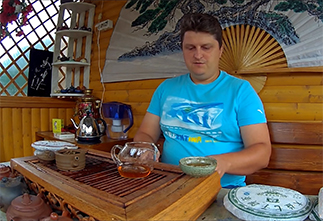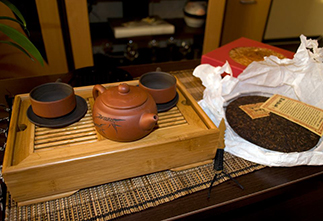Shu Puer 2019 from the Xiaguan factory: A treasure for connoisseurs
Xiaguan Tea Factory is a name that has been associated with the highest quality of Chinese puer for over 80 years. Founded in 1941, this factory has come a long way, becoming one of the leaders in the tea industry. Its products are valued both in China and far beyond its borders.
Shu Puer 2019 – a masterpiece from Xiaguan
One of the highlights of Xiaguan's range is Shu Pu'er 2019. Pressed into a traditional cake weighing 357 grams, this tea is a real treasure for pu'er lovers.
What makes this tea special?
- Traditions and innovations: Xiaguan carefully preserves the traditions of puer production, but at the same time actively introduces modern technologies, which allows creating tea of the highest quality.
- Careful selection of raw materials: This puerh is produced using the middle leaf and fleshy golden buds, which provides a rich and balanced taste.
- Soft Press: Soft pressing allows the tea to break easily, making the brewing process easier.
- Incredible taste: The taste of this puer is a real discovery for connoisseurs. Soft, woody, with delicate creamy notes, it has an incredibly dessert character and a long aftertaste of milk chocolate. When brewed using the infusion method, this tea resembles Nesquik cocoa.
Why is it worth trying this pu-erh?
- For lovers of sweet and dessert flavors: If you prefer pu-erhs with a soft and sweet taste, then this tea will definitely suit your taste.
- For Beginners: With its balanced taste, this pu-erh is perfect for those who are just starting their acquaintance with pu-erhs.
- For Collectors: This tea will make a great addition to any pu-erh collection.
Shu Puer 2019 from the Xiaguan plant is a true masterpiece of tea art. Its rich taste and aroma will allow you to enjoy every cup. If you want to get acquainted with real Chinese puer, then this tea is an excellent choice.
|
Name in Chinese
|
云南下关沱茶 |
|
Pinyin
|
Yúnnán xià guān tuóchá jítuán |
|
English name
|
Shu Puer 2019 |
|
Translation
|
Shu Puer 2019 |
|
Country
|
China |
|
District
|
Dali-Bay Autonomous Region |
|
Provinces
|
Yunnan (云南) |
|
Prefecture
|
Dali |
|
Habitat
|
Дали (大理, dàlǐ) |
|
Manufacturer
|
Сягуань (云南下关沱茶集团) |
|
Raw material production date
|
2019 |
|
Year of pressing
|
2019 |
|
Pressing form
|
Bing Cha (Cake Tea) |
|
Declared weight, g
|
357 |
|
Tea tree (bush) variety
|
Da Ye Zhong |
|
Size
|
20x20x2 |
|
Length, cm
|
20 |
|
Width, cm
|
20 |
- Комментарии
- Вконтакте
Pu-erh is one of the most unique types of tea, which only gets better with age. Many people, when they first encounter this tea, wondered: why is pu-erh more often found in pressed form (cakes, bricks, tochas), and not in loose form? The reasons for this are related to both history and the practical aspects of storing and fermenting tea. Despite modern technologies that allow the production of loose pu-erh, the shape of pressed cakes remains unchanged. And pu-erh is more often found on sale in pressed form, for example, in the form of cakes or bricks, and loose pu-erh is less common. We will talk about the reasons for pressing pu-erh into cakes in this article.
Puer is a unique Chinese tea that is distinguished by its depth of taste, complexity of aromas and versatility of aftertaste. Its taste characteristics are formed under the influence of many factors, from growing conditions to the brewing method. Let's look at the main ones.
The question often arises: how to brew puerh correctly? Sometimes the phrase "to get high" is added to it. Moreover, everyone has their own understanding of this phrase. Some mean vigor, and some - intoxication. So how to brew puerh tea correctly? Let's consider several options.
Traveling through the tea mountains, we found ourselves in another land of blue roofs - the village of Zhongcai, which is located in the Menghai district of Yunnan province. According to tradition, we were shown another local tea tree, which, according to the Chinese, is at least a million years old :) The village is very authentic, not designed for tourists, there are many wild pu-erhs there and, of course, we were warmly received. They treated us to local cuisine and tea. We also asked the residents about the prices of tea and how they have changed in recent years.
The tea ceremony occupies a special place in the centuries-old Eastern tradition. And although the essence of this phenomenon remains constant, the nature and external manifestations of the tea ceremony in different nations have their own national characteristics. In each Chinese province, the tea ceremony and the tea used in it are varied: for example, residents of the southern provinces prefer green tea, and residents of the northern provinces - red tea, in Fujian province they more often use Oolong tea, and in Yunnan province Puer tea is widely known.


























































































